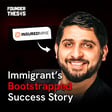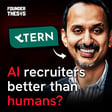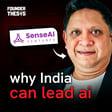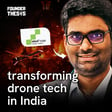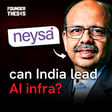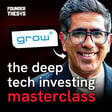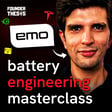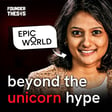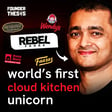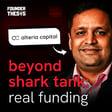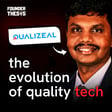Introduction to Vehant Technologies
00:00:00
Speaker
I can bet that almost all of you who are listening to this episode of the founder thesis podcast would have interacted with Weihan's products. The next time you go into an airport or an office building, take a look at the brand name on the baggage scanner that they are using. There's a very high chance that you will see Weihan's logo on it.
00:00:18
Speaker
But Vehant is so much more than a company that makes x-ray baggage scanners. And in this episode of the Founder Thesis Podcast, your host Akshay Dutt interviews Kapil Bardeja, who founded the company pretty much straight out of college. The humble startup that was born in the dorm rooms of IIT Delhi is today helping the government power futuristic smart city projects and bring India at par with the Western world. in terms of security infrastructure.
Kapil Bardeja's Entrepreneurial Journey
00:00:43
Speaker
Stay tuned for a deep dive into the business of security and safety and subscribe to the founder thesis podcast on YouTube or any audio streaming app. Kapil, welcome to the founder thesis podcast. I want to learn how you became an entrepreneur and you were a very, very young entrepreneur. So can you connect the dots and tell me how that happened?
00:01:04
Speaker
So I belong to a business family. My father was actually in the auto parts business and right from sixth standard. three standards sorry He was a trader? and Was he a trader? No, no. So both manufacturer and trading. So we had, so there was something called a ambassador-feared cars, if you recall, in the 70s, 80s. So he was manufacturing the hounding assembly and electrical wiring harness for those
Founding of Vehant Technologies
00:01:31
Speaker
cars. And then we also had a shop in Kashmiri Gate, which was the auto hub. And we had three factories at across Delhi.
00:01:38
Speaker
So, initial days of entrepreneurship were funny because right from 6-7 standard, the you know I was going to this manufacturing setup as well as the shop we had. So, the smell of money was exciting from the beginning. And those were the initial days when you actually start to learn you know how do to make money, you know how to buy things, make them, sell them. so So, those were the initial, I would say, sitting points of entrepreneurship.
00:02:06
Speaker
As I kind of moved on, graduated, studies became critical. and then But I was always clear that I had to start something of my own. so So you you joined IIT Delhi which at that time there were much fewer IITs and it was a much bigger deal. You didn't want to sit for placements after that or like what happened once you... So so actually I'm ah i'm an MBA from IIT Delhi just to kind of clarify. So my co-founder actually is a Computer Science graduate from IIT Delhi. So we take MBA from IIT.
00:02:38
Speaker
So that's a funny story and I'm actually a bachelor in pharmaceutical sciences because my initial plan was to start something in the pharmaceutical manufacturing. Got excited about medicine and stuff. But then got into IID for a post graduate MBA program in IID Delhi. That kind of opened up the technology horizon so to say that you know IT and stuff was picking up. This is 2003 I'm talking to.
00:03:00
Speaker
IID started the incubation program in 2002. So, IID was the second incubator, IID Delhi. IID Bombay was the first incubator. And ah there there was a group of 12 people in the computer science department, seven B.T.M. tech, there's a dual degree program in IID Delhi, there still is. And there are five professors who want to to start a company.
00:03:23
Speaker
So, and I was doing my MBA at that time, so they reached out to the management department to kind of, to one of my guides, Rasa mobile, to kind of ah teach this fresh ah but graduates how to do a business, like how to do pricing, costing all that. So I got in touch with this group when I was in IIT, so that's how we kind of met.
Early Challenges and Funding
00:03:44
Speaker
Now, I actually run Vehan with one of those founders. That's another story we kind of spun off the business. So ah the initial company which was started was Critical Solutions Private Limited way back in 2001, 2002. And then you graduate. I graduated in 2003.
00:04:04
Speaker
So when Kritikal was getting founded, I was still studying and these guys graduated in 2002. I actually had a small stint in McKinsey for nine months, but the plan was that I will join their business once they you know, the initial dust is settled and they'll figure out the structure and stuff. So I had some time in between and, you know, I joined McKinsey for about nine months. And then I kind of came back and joined the team as the business guy, so to say. And you you joined with like a founder equity kind of a thing or as an early employee? No, I was a head of founder equity. Yeah. Okay. Okay. Okay. So you were the business guy and the others, but 12 founders you said.
00:04:46
Speaker
That's a huge lot. yeah Incredibly unwieldy. like the The probability of success for a company with 12 founders is miniscule. They are pros and cons. so the There were 7 full-time guys and 5 professors like and I was the 8th one. The challenge was essentially decision decision and making was very difficult.
00:05:09
Speaker
because when 13 people sat on a table and everybody had equal say, you can't make
Product Development and Market Entry
00:05:14
Speaker
a decision. But nevertheless, I think things were aligned and Critical Solutions started working as a R&D design house for various businesses. So essentially we could not agree on a product and we said, okay, let's do services till the time we figure out a product.
00:05:27
Speaker
ah We did that for two years, we reached out to defense. What kind of services as a defense? So we were doing a lot of, ah so the core area of expertise was, ah no, computer vision, that was one area of expertise, which is essentially now which is AIML morphed into that, it was called computer vision at that time, and then embedded design.
00:05:45
Speaker
So a lot of things on the embedded side, you know building these electronic boards, putting software in that. So we did a lot of exciting projects were for defense, for private companies who were selling in defense. So embedded design would be, for example, I remember the that these traffic policemen and started carrying a device on which they could issue a chalan on the spot. And this was probably an internet connected handheld device for issuing chalan. So that's an example of embedded system.
00:06:13
Speaker
Yeah, so that's not exactly what we did, but we actually built a metering box. So there was a box we built with a with a processor, printer, TFT screen, a wireless, where people would carry that to a electricity meter and then take a picture of the meter and also print a bill there.
00:06:33
Speaker
Now we have these remote monitoring things, but at that time people had to carry these boxes So this box can essentially be used for police channeling also, but that was a box we actually built for a company It was into that you know electricity metering business, right? Okay, so da what is nazi like captured by China, right? I guess most of such devices come from China only love in India No, there are people who are making them in India, but the bulk of them stay down from China because the scales are different. So economies are there, but there are companies who actually design and build these boxes in India. Okay, got it. So yeah, so 12 people, services, business. We also got a project from the minister of information technology, which was DID at that time, Department of Information Technology.
00:07:17
Speaker
to build a under vehicle scanning system. So this started from the parliament attack in 2001. Parliament kind of upgraded their security, spent about 100 crores at that time in various gadgets and there were two under vehicle scanning systems which were imported from UK, each costing a about a crore.
00:07:37
Speaker
So it was the parliament security at that time was essentially an ID Delhi graduate, an IPS officer. But from ID Delhi, he came to one of our professors and said, you know it looks like a very simple product, but summer is very expensive and we need more of these because we have a lot of gates. So can we build this in India? So that was the problem statement he gave. So at the same time, we were actually kind of looking for projects.
00:08:00
Speaker
ah So, we went to the parliament, we saw the system, it looked like a fairly simple system using cameras and that was an expertise we had in computer vision. Essentially, playing around with cameras, building mosaics, finding patterns out of images and stuff. So, Under vehicle scanner was exactly the same product.
00:08:15
Speaker
so We got some funding from DIT. Actually, IID Delhi got a funding, and part of that came to the company as a project, so to say, to kind of essentially develop the interface, mechanical, somebody else did, and we kind of integrated that project. So product was developed, the product was developed, and we demonstrated that to security agencies. And then it clicked to me and one of the co-founders, Anup, who is now my co-founder in Vehan.
00:08:44
Speaker
that this could be a product we can actually commercialize. and We can take it to the market and actually build a company around it and then you know add more security products. um But as usual, 12 people decision making was difficult. So nobody wanted to take the risk because you know, the services business was doing okay. We were generating more controls of revenue, reasonably good for a startup at that time and profitable. So we kind of took the bullet and bit the bullet and said, we want to start a company and commercialize it with the scaling system.
00:09:15
Speaker
So we spun off behind technologies from the parent, which is critical solutions ah to essentially focus on building, design, developing, selling products. Under vehicle scanner, IP is what we took from the parent and started behind as a company. So under vehicle scanner is actually a first product. And how was the equity of it worked out? Like how much equity did the two of you get? How much was with critical?
00:09:41
Speaker
So Critical got, I mean, so i mean ah it's a long story, but currently they have 20% equity in lieu of the IP, the transfer. We also required money to develop the product further because what we developed was a proto. It had to be recognized and stuff.
00:09:58
Speaker
So we got an angel investor. The investor was the same person. We developed another device for him for car security. So he liked us and we thought it's a great idea and company can do well. So he kind of funded us. So the angel investor holds about 27% equity now.
00:10:16
Speaker
He gave us 80 lakhs, 40 lakhs equity, 40 lakhs soft loan. So that was the first raise we had of 80 lakhs. This is 2003 I am referring to.
Diversification and Technological Innovation
00:10:27
Speaker
So that's how we started and the balance equity is between me and Rup. And now about 10 key members of the firm hold about 10% equity. equity okay
00:10:39
Speaker
this like Probably critical would have had more equity earlier on and you would have bought them out over time or something like that would have happened. Yeah, so we had an arrangement of a milestone based kind of movement. so yeah I'm really astonished at how maturely this was handled. Something like this. ah I mean, there are so many chances of entering into a bad deal which you later on regret and the bad deal causes things to not really scale too much. But it looks like there was a lot of foresight in how you structured it. It was a challenge. I mean, getting 13 people to agree on a structure, even spinning off a company, taking a technology.
00:11:25
Speaker
But I think people who mature and they understood. So the critical solution wanted to focus in on services. So product was not something they wanted to do at that time. So it was easier from that perspective that you know we don't want to do product. When you want to take the risk, you can take it. And you know so that way it was done well, but it took some time, almost six months of convincing discussions to kind of really figure out the structure. So yeah, but it finally happened.
00:11:53
Speaker
Okay, so what next you are now starting you have IP you have 80 lakhs in the bank But you don't have any customers. You don't have a like an MVP like a minimum viable product yet How tell me the journey from here?
00:12:08
Speaker
So this is 2005, I assume. This is 2005. So we started bi behind in 2005, with the intellects in the bank, as you said, and the IT, and me and Arup, certain people. So we started building the team because we knew this product was a prototype at best, but it's not a ruggedized, validated product.
00:12:26
Speaker
So we started validating it, eventually and ended up ending up changing the whole technology all together. It took us almost 2 years, we finished 80 lakhs sooner than we expected and then we were back to square one saying that you know how do we really now raise more money because we are now into it, we have to do it.
00:12:48
Speaker
So, how do we raise more money? What was the spend on like what did you spend that 80 lakhs on? So, it was essentially on you know we had to redo and the structure, we had to redo the algorithms.
00:13:03
Speaker
We actually changed the whole technology narrative from an area scan system. We were using a four camera systems to check the underside to a single camera line scan system which was I would say more ruggedized and more repeatable in terms of detection.
00:13:22
Speaker
so So we actually ended up changing the technology altogether. The the earlier system would have been the entire car ah in one go. Now it is that as the car is crossing the camera, it's like how photocopy happens, like the line.
00:13:38
Speaker
page um Yeah, so the mechanism was similar in the proto also, but we were using something called area scan cameras, which basically meant that, you know, and the area scan camera technology was not very evolved at that time. We used to get PAL cameras, which is 760 resolution. Now we have 2 megapixel fiber. So these are essentially 760 across, you know, 640 resolution cameras. So it was analog cameras at that time. I'm talking about 17 years back. The IP camera was not that famous.
00:14:07
Speaker
So that was one of the challenges because the speed of the vehicle the system could attend was only 7 to 10 kilometers per hour, which means the vehicle has to slow down, really goes slow on the scanner. But the customer wanted more and no faster kind of system, they don't have to stop the car, the car can just pass and then we should be able to generate the mosaic of the underside and then do some pattern recognition.
00:14:28
Speaker
So we realized that this camera would take some time because the camera technology hadn't evolved at that tech time. So we actually moved to something called a line scan camera system, which was actually a photocopier, as you said, where it does not bother about the car. It essentially, as the car moves, it essentially scans line by line information and then kind of places them together to form a mosaic of the underside. So the mosaic formation was essentially a camera feature, so to say. It was not the software which was doing it as in the case of the area scan cameras, which we use.
00:14:59
Speaker
Interestingly, 12 years back, we developed the same system, but now with better area scan cameras, which is a Gen 3 system. So fast forward that. So we developed that line scan technology.
00:15:10
Speaker
And so it took more time because we had to redo the whole technology stack, ah finish the money. ah So we went to TDB, technology development board at that time, and we wanted to raise some money. And then there was an ICICI spread program at that time, which they had some world bank money which they could give at 5% or 6% loan. So we actually raised two more crores from these two loans. So 5% loan from TDB and 6% loan from ICICI spread.
00:15:37
Speaker
And that's how we finished the under equal scanner. So 80 life was not sufficient. We actually ended up spending three crores to essentially come out with a minimal viable product, which the
Growth and Strategic Hiring
00:15:47
Speaker
customers could buy. and A lot of people at this stage would have given up instead of taking a loan because we're talking of like in an era where debt was a bad word. Right. I mean, my parents never would have bought anything on EMI simply we because for them debt was a bad word. Why were you so confident that you can take a loan, take on debt and still manage to pay it back without getting bankrupt and with the bank behind you, you know, a nightmare scenario that you get in debt and no way to pay it back.
00:16:25
Speaker
So, I think I was pretty confident, Anoop was also confident that we can sell this product. There was a market, there was no Indian company, there were two global companies and they were very expensive and they had no reach in India. When we did a business case for this product as such, we added up you know multiple high security installations like you know ah Parliament, President's House, Chief Minister's Residence, Supreme Court.
00:16:50
Speaker
chemical plants, power plants, all that, who would essentially need a system. And ah they were using a mirror to check the underside. So there was a need to check the underside. So the the whole concept was there. If you wanted to check the underside, but you wanted a technology or system which could help you do it more reliably. So I think we were confident that the product would sell. It's essentially a product problem. And once we developed the product, we were confident that we'd be able to sell it.
00:17:19
Speaker
We got some initial sales. ah Actually, even the proto, we were able to sell to Bangalore Chief Minister's residence ah took silver to stabilize the product, but finally it was working. And for the last 18 years, we have changed it twice into Gen 2, Gen 3, and it is still there. So as a under so we were confident that we would be able to pay back the money. and I mean, we had a passion when we wanted to do it, so come whatever way.
00:17:48
Speaker
When did it reach the stage where it was ready for commercialization? So 2007, you took another two corrodes. After that, how much longer did it take? So 2008 was something where it was ready to sell. And that's where we started, I would say commercial sales of the product. So two and a half years from the starting point.
00:18:13
Speaker
this like you know For an outsider, selling something to the government just seems like you don't even know where to start. like If I was selling something to the private sector, I know that I will go on LinkedIn, find people, send them a cold email.
00:18:29
Speaker
go to events, meet people at events. But but how do you do government sales? How did you do your initial sales? I think the first thing we realized was that both of us had very limited expertise in that area. So the fifth person we hired was actually a senior salesperson. So Tumkarju was still with us. He's one of the directors in the company. So he had 22 years of experience with HCL and L&T and stuff. And he was good in government sales.
00:18:57
Speaker
so September 2005 he joined us, I'll call him. And I think he has been taking the sales mental since then. Of course we've had a mental problem. How do you convince him? Like a bunch of 20 year olds telling a 45 year old guy to come and work for them?
00:19:16
Speaker
I mean we had four or five interactions, so we had a small office because we moved out of IID incubation program and then we came to Noida in sector two, we had a small office on the back side, you know there was a generator place people used to have. So this got converted that into an office space of 20 people and give it to us. 50,000 rupees was the right thing to call correctly.
00:19:36
Speaker
So he came to that place. He was in HCL, of course, head of the AMD line of business. So his initial reaction was, where whereby what am I doing here? I think over subsequent conversations, we were able to convince him about the long-term vision. I mean, we have to ask him whether he made a mistake or not. but sounds So that we realized our weaknesses. That's very important for any entrepreneurs to look at. you know know what you're good at and then go find experts in other areas. If you try to learn that expertise, you'll take more time. You will learn that expertise eventually because you know, as we go through the journey, but initially you need to really find experts of something you don't know. So yeah. Okay. Okay. So he helped you to start getting sales. What did, what like first few years, what kind of deals did you do that you recall?
00:20:27
Speaker
It was a very slow adoption because we were essentially changing a 5000 rupee mirror to a 20 lakh rupee device. So there was a huge leap of faith the customer had to take ah to essentially see value in that product.
00:20:42
Speaker
we In 2007, we sold five units. If I recall correctly, in 2008, we sold about 15 units. Each unit is about 20 lakhs, so it will give you a sense of the revenue. But we were clear this is not the product that's the only product we want to bid. We want to move ahead and add new products and technologies. We added one product after to the other. But the minimum viable sales started coming after 2008 onwards. And what kind of sales were you doing? By 2010, say what kind of annual revenue were you at?
00:21:11
Speaker
So, a we were doing close to about 10 crores, 12 crores by that time. we had but By 2010, we had actually added one more product in the TT, which was also an extension of a numerical scanner. so we essentially So, you have the underside of the car, but we were putting a camera to take a number plate and a camera to take a driver snapshot to make it a complete complete solution.
00:21:35
Speaker
Now a lot of customers said that, you know, the rental plate, they have to digitize because we give them a picture and then they have to type the number. So we said, yeah, it's a fairly simple, optimal character recognition technology. It's globally available. We took a license from a company in Germany and Hungary and we tested that on Indian plates. Accuracy was 20% of detection. So we send it back to the OEM saying that is the number plate reader is not working, what do we do?
00:22:00
Speaker
So they told us to send us some samples and they were like all funny handwritten plates with Gemma Tati on top of that and stuff. They said, you know, our engines don't work like that. You need to have standard characters and stuff. I said, we don't have standard plates. So he said, I'm sorry, we can't work. So we ended up developing an OCR engine. general for reading the car plates. And then we started selling that as an add-on to the system. So we sold a couple of scanners to Rajasthan police and one of the s SP who then became SP traffic ah came to us and said, you know can you use the number plate reader to track the vehicles going in and out of the city, Jaipur city.
00:22:39
Speaker
And we said, yeah, it looks like a simple concept, same camera, we have to just put it and you know ensure that it works on high speed because the vehicles are higher speeds than ah on an entry of a premise. So we deployed, we got an order from him for deploying 20 lanes of only number plate reading systems for the city of Jaipur.
00:22:58
Speaker
But there's still operational value. So ah that was a good revenue. We sold the 50 lap order for 20 lanes, but we had to do the hardware in the polls and lights and everything. So we learned all that. But then eventually that morphed into ah a new business. We called it where he's kept as a product category. And we started selling that to various state police for monitoring of vehicles ah going in and out of city.
00:23:21
Speaker
where you have a local detection and the data goes centrally. So something, let's say it's a stolen car, you feed that number centrally, and then it will give you a pop-up whenever any camera sees the car at any of the junctions. So that became our second product, so to say. So by 2010, we were also selling weight scanning.
00:23:37
Speaker
Okay, um amazing. ah what Where is the camera typically mounted for reading the number plate? Is it up on top like there is typically like the there's a pole on top of the road? Is it there or is it on some corner on the side pointing towards the road?
00:23:52
Speaker
So both configurations are possible depending on the width of the lane. If it's a two lane road, then a side pole is good enough because any, any structure which you take up has to be then six meters and above. If it's that's a standard for all the safety standard, because the ambulances and other things have to pass through. So, but if it's a three lane road, then you have to have either a cantilever structure, which is at least six meters or a gantry, which covers the whole side of the lane.
Expansion into Private Sector
00:24:17
Speaker
So, all three configurations are possible, you have a side pole, you have a cantilever structure and you have a gallery structure. ah Cantilever means it just goes up to the middle, it does not. Yeah, it does not cross to the hole in, but it has to be at least 6 meters cantilever. So, it does not hit the vehicle going below.
00:24:35
Speaker
okay okay and So all of this sounds like a lot of relationship building happened because for ah for like the police departments to come to you and tell you that can you do this and what was powering these relationships?
00:24:52
Speaker
So I think ah once you start working with let's say police or even defense for example, they have a lot of problems they want people to solve and you know the this era was when only foreign companies had technology and foreign companies don't modify their products and solutions to meet your small requirement. right So that was a constant challenge for these companies also. So I think we were able to somehow convince them that we are there for their solutions and we were also hungry for getting ideas because we wanted to build a product. But our thought was always that, you know, sniff the market what they require, let's build that. It's available globally, but it's not suited for the Indian conditions. So I think the whole thought was to actually build technologies and products which the customer wanted, not available in India, foreign players are not willing to do any changes. So that's a product we kind of entered. And that's our third product happened, which was X-ray, X-ray baggage scanner machines.
00:25:47
Speaker
So we actually were the first excavated scanner manufacturer in the country. For single view systems, which are essentially you know one generator, one detector array, so you get a bottom view of the bank. So that was the initial technology and still that is being mass deployed across, if you go to hotels or railway stations and stuff, they still use single view scanners.
00:26:08
Speaker
So, it's actually those credit poolers who actually told us that you know this is an X-ray technology. you know We buy it from foreign companies. They're very expensive. Then you know for changing the conveyor belt, they charge 60,000 rupees. We know it's a 10,000 rupee belt, but they charge 60, and we don't have a choice. So, we started developing X-ray baggage machines.
00:26:29
Speaker
This was way back in 2012. We sold our first X-ray battery machine. Again, we we had entered the police, you know, high security market with our vehicle scanner. So X-ray became a logical choice. We later diversified to hotels, you know, IT companies, private complexes also. They also bought our vehicle scanner. So TCS, Cognizant, HCL also had our vehicle scanning systems.
00:26:53
Speaker
Marriott Hotel, ITC, had our individual scanning systems. And then eventually we sold the same product. So the idea was to only look at products with this customer to require, reduce our say cost of sales. We have a sales guy going there with our individual scanner catalog, can go with an x-ray. They need an x-ray. But it was a leap of faith in terms of developing the technology because we were not expert on x-ray. This was more physics. We had to first understand the physics of it. And then eventually when it came to imaging, we knew what to do.
00:27:18
Speaker
So, that's that's how we build the X-ray. Move that single view to dual view X-ray baggage scanners, which were aviation related products. Aviation has higher standards of X-ray. What is the difference between single view? Single view has one generator, one detector array. So, you get a bottom view of the bag. Aviation necessitates a dual view system where you have two generators and two detectors. So, you get a better imaging and better detection because you are looking at the bag, let's say from the side view and the bottom view.
00:27:47
Speaker
Eventually, we will move to a computer tomography system, which we are also not developing. In the country, we move to that. The Western world has already moved to a CT scanner, but we are still at the dual view phase, which I think is a graduation we will do that. So a CT scanner is like 360 degree.
00:28:04
Speaker
yeah So CT will actually take a complete 360 degree view on the back, like a medical CT. And it will be more reliable. We'll have more data points for the algorithms to detect explosives or objects in the bags which are harmful. And who was leading technology? And who was like the technology head? or like How did you? Because all of these are like hard tech problems. Yeah.
00:28:30
Speaker
So Anup is the tech guy. I do everything which is not tech. I mean, you end up learning a lot of poor products, but Anup actually leads all the technology initiatives. Very, very keen learner, because you know, moving from computer computer vision, camera imaging to X-ray imaging, radar technologies. Now we move into radio imaging also by the way. So we are developing scanners for detection of, so you see these in US and Europe, you have these body scanners where you have to stand like this or stand like that. And they essentially have millimeter wave technology, which is not penetrating technology because you can't penetrate a human every time through an X-ray. It's kind of regulated. For baggages you can do, you know the bags you can scan through X-ray.
00:29:13
Speaker
So, we are also developing millimeter wave scanners for the aviation application. yeah After you generate the image, it's a similar computer vision AIML problem, but then to generate that image you have to solve a lot of physics and electronic problem, which we kind of you know learned and we were always curious to learn new things. So, we developed these products one after the other.
00:29:37
Speaker
When did you launch the baggage scanner? So baggage scanner was 2012, if I recall correctly, our first scanner was sold, single-use scanner. And when did you diversify into the private market like hotels and IT parks? So with UBSS we started moving into private in 2009-10 where we actually cracked DCS as a customer. UBSS is underwayker under vehicle scanning system. So we entered everywhere with under vehicle scanning system and then kind of topped it up with an X-ray machine because these are all required for checking the car or checking the bag.
00:30:16
Speaker
okay okay Okay, so as on date what all so like 12 you launched the baguette scanner after that any additional launches or like just yeah, so we have complete so now we are kind of into So, one thing I skipped was the number plate reading system actually morphed into a new business segment of not just monitoring the vehicles. So again, we listened to the police and they said, if you have a number plate reading system, can't you detect a violation? Can you detect an over speeding, a red light jump, no helmet, triple riding? So we actually morphed the number plate reading system where you scan a product into something called traffic mall. That's a category of products we have for traffic violation detection.
00:30:57
Speaker
which was essentially speed detection, number plate, ah red light, stop vehicle, parking violation, all that. Here also, it's a funny story because when these customers started asking us speed violation, and we said, you know there are it's a globally solved the problem. Western Welder already has speed scanners for the last 25 years. Went to a German company, took a radar, and said, we're going to take a radar, detect the speed of the radar, and we have a number plate reader anyways, and then we're going to combine it, because violation detection and you know number plate has to be generated.
00:31:27
Speaker
You detect a violation, don't have the number of rate, you have no value because you can't generate a ticket. it So we look at these radars and we put them in one of the junctions in Noida we had, as a test junction so to say. So the accuracy of detection was 30% and then we asked the OEM again, said you know he said okay send me pictures of the junction, we have put up my radar.
00:31:49
Speaker
And we sent them a typical Indian junction which had three lanes, four cars, three two-wheelers in between, and two rickshaws on the backside. So there were eight vehicles in the view, so to say. And we said, what is this? you know This is not how the radars are developed. I said, what's the problem? I said, I can see from my eyes different. I said, no, radar cannot do that. You know we need a certain level of separation. So I need three vehicles, three lanes, three vehicles. If you have, then the radar will work. Otherwise, it won't work. I said, it won't work in 99% of the places in India, maybe 1%.
00:32:18
Speaker
So, we brainstormed, we went back to the drawing board and said how do we solve this problem. So, and then Anoop came out with this beautiful algorithm algorithm to detect the speed of a vehicle using cameras. ah We did a distance upon time, so it did required some calibration of the ground. So, we knew the exact position position of the plate. I mean the idea was that every vehicle has a plate. So, if I detect, I detect the plate anyways because there number of plate reasons, but I track this plate in time and I look at the speed of the plate.
00:32:48
Speaker
to, and then correspond that to the speed of the vehicle. So if let's say you run with a plate in front of my system, I detect your speed because I'm actually detecting the speed of this moving plate. So that was a whole concept. And then we tested that, validated that, showed it
Pandemic Pivot and Product Innovation
00:33:02
Speaker
to the customer. So there were a lot of initial resistance because it had us what are the norms, but they were very expensive. Each system, I know Delhi bought some systems in 2008, nine, $60,000 for one approach.
00:33:14
Speaker
I mean, it's crazy pricing at that time. And the camera-based systems were good because we use the same camera for detecting speed and the number grade. You don't need a separate camera. And this was per lanes of a three lanes, you need three such systems and combine them together in a processing unit and then send the challenge to the junction.
00:33:31
Speaker
So I can very proudly say that we actually changed the whole enforcement landscape in the country. Fast forward to 2024. Now we have 20,000. How much did your system cost? You said the important system was $60,000. So we were selling at that time at $4,000.
00:33:47
Speaker
Wow, okay. So there was a... And accuracy was comparable, like in terms of... So we were lower than the radar. The radars are more accurate. But again, you need to have a situation for the radar to be accurate. If you have three lanes, three cars, radar would be almost 99% accurate. But you don't have that. So even if our systems are 80% accurate, that's good enough because you're missing 20 volunteers, but you're getting 80, but it won't end the price.
00:34:11
Speaker
right So the challenge was not getting a wrong violation. That was critical. you know Don't capture a vehicle and and define that to be over speed when he's not over speeding. But even if you miss 20 vehicles, you're over speeding. I mean, you live with that, right? with one tense price system So that was the whole game. So fast forward. Now we have 20,000 enforcement slash vehicle monitoring lanes running across 70 cities is in India.
00:34:37
Speaker
Our competitors also followed, so you know they also, Jang Verda started developing camera-based system. So I can proudly say almost 95% of the lanes deployed in the country, whether it by Aspar or by competitors, are camera-based and And any other products that you developed in this journey? So, ah I mean, ah traffic mode, we added a lot of modules. So after speed, red light, we added no helmet, triple riding detection,
00:35:05
Speaker
wrong way, seat belt detection, mobile wire driving detection, all that we did as enforcement piece, so to say. ah Covid it was a game changer for us. So, you know we have three divisions now. One is security screening, which is under vehicle scanners, X-ray package scanners,
00:35:23
Speaker
We also developed an explosive trace detector along with a company in ID Bombay. It's using a BEM semiconductor technology which we don't understand. So we actually took a technology from them and kind of added to our aviation portfolio. And we are adding millimeter wave scanners, computer tomography systems now being developed now in this division. Second division is smart city system. How does the explosive detection happen? What is this technology? So this is a micro electro mechanical sensing technology. It's a semiconductor device.
00:35:53
Speaker
So in 2011, I ah you saw an article from a professor, for Professor Ram Kupal Rao in IID Bombay. And they claimed that they developed an explosive detection sensor in the country. And us we were selling to these high security areas and explosive detection was an interest to us. So I called him up, I said, you know, I want to meet up and give the background for Pehan. So he said, yeah, come on, I have just half an hour. So I flew to Bombay, met him. We almost spent four hours together, had lunch. And then I figured out that it was a complex technology.
00:36:28
Speaker
they And we came from the academic background. So we know that when a professor says that technology is developed, only the concept is developed. I mean, you have to really take that to a proto and then, you know, scale technology. So they wanted to start a company. So we helped them incubate a company because we are understanding we don't have that expertise of working on semiconductor devices. One of his ex-students is the CEO of that company. He's a PhD in microelectronics. So that's how it happened. And then we essentially took the manufacturing for that technology because they were not experts in manufacturing.
00:37:06
Speaker
We had this factory set up, all that, you know so we added that. And we took the rights for selling the product in multiple countries. okay okay okay guard it okay yeah sorry So you were saying COVID was a game changer. Yeah, so in COVID, all the airports were shut down.
00:37:27
Speaker
All the hotels were closed. eighty um What was your revenue in 2020? Like around that that financial year, 1920, what were you at? So pre-COVID we were hitting 64 roads so and and we projected to be 100 in next next year because everything was going well and and then COVID struck. So smart cities were shut down. There was no vehicle on the road.
00:37:49
Speaker
So, and we sat down, the drawing board says, none of our products will set from tomorrow because nobody wants an under vehicle scanner when the building is shut down. In fact, people stop renewing their AMC contracts also. So the AMC contracts, they said, you know, I don't know where till the time what my code will be closed. It's almost a year. Even if it is open, I don't know how many people will come and stuff like that. So we we looked at the suite of products and technologies which you could develop.
00:38:14
Speaker
So we developed four COVID related products in a short span of six months during COVID. So from, let's say March 2020, even the COVID hit. So we developed a UV tunnel, a UV disinfecting system using our existing x-ray baggage tunnels. We got in touch with a professor in IID Bombay who was expert on the biology side of it. He told us this is the dose required, this is the UV lab you require. So we actually retrofitted our tunnels to make a UV scanner and we had the conveyors and everything right, so it's the back.
00:38:47
Speaker
So we sold a couple of these tunnels, actually 100 of them to our existing customers who started using extra machines, but they had to sanitize the bag. So if you recall, there was a lot of, you know, human crying with regards to the bags having some infection, you know, and vegetables having infections, stuff like that. So we developed a UV tunnel. We even exported these UV tunnels to Philippines, Switzerland. Again, these are online queries and we posted everything.
00:39:14
Speaker
Second was we developed a, so we had worked on thermal cameras for monitoring applications. So we retrofitted one of the thermal cameras to do temperature detection. So there was a challenge where you know we have to enter the place, your temperature should not be high. So we sold again hundreds of these cameras for temperature monitoring.
00:39:32
Speaker
So we actually did not do anything which were traditional business. We developed these new technology in six months time, launched them, sold them. We also developed, so in for example, and all these, you know, traffic systems which we sold, there was no vehicle on the road. We got a call from the Hyderabad police. There was some regulation in Telangana that, you know, if you have to move out for buying grocery, you can only go three kilometers. You can't go beyond that.
00:40:00
Speaker
Now how do you monitor that? So we actually developed a small algorithm where you know the number plate readers we had. So we knew exactly when the vehicle is there and at that point. So whenever he was crossing three kilometers, we generated a ticket. so And then we started detecting masks. The person is wearing a mask. So this COVID analytics, we called it, so to say, to buff. So there were four products we launched, which was UV tunnel, temperature monitoring, distance measuring systems, mask detection systems, and things.
00:40:30
Speaker
And we sold, I mean we we survived COVID, we went down in sales, 64, we got 53, but we we still made money, we were profitable, and we didn't lay off a single person. I mean, we didn't do hike in in that year, that was the only year we didn't give any hikes, but we never laid off anybody. So you know this quick adaptability was very, very good, the team really worked hard, all of them, and we were able to sail through the COVID period.
00:40:54
Speaker
ah Now, since we were developing this COVID analytics, we always wanted to get into people analytics. So we were doing vehicle analytics, which was detecting vehicles, speed, monitoring, count, all that, but we never went into people analytics. When we started doing masks and people detection, so we said, let's now get for people analytics. So that's another business vertical we have started called enterprise analytics.
00:41:18
Speaker
which is essentially people analytics using cameras where you can detect patterns. So now fast forward three years. Over the last three years, we have launched something called a vehicle incident detection module for highways, which detects the speed of a vehicle, wrong way, collision, slow vehicle, something, you know,
00:41:43
Speaker
dropping off the vehicle and things like that. So it's a nine analytics suite which NHAI is now kind of mandated for all the highways and we have got our almost 600 of this these lanes deployed in five highways right now and there is a huge plan to kind of deploy these systems.
00:41:58
Speaker
ah We also developed safe city analytics, which was actually an extension of the COVID analytics, wherein we were selling the traffic enforcement systems to the city as part of the smart city mission. But then safe city was essentially analytics like crowd detection, crowd management, loitering, left baggage detection, somebody garbage on the road, fire and smoke detection. So all that analytics came as part of the safe city analytics.
00:42:22
Speaker
So we have now launched a module for safe city analytics, almost one and a half years back, where we got multiple cities like Jammu, Kurgaon, where we are not just selling the traffic analytics, but we are also selling the safe city analytics as part of that system. So that was another vertical with standard.
00:42:38
Speaker
Third thing which we did was to look at industries and manufacturing where we were already present to run vehicle scanners and extract and like oil and gas installations where we have a module which does multiple such analytics which they require for safety compliances like you know whether the person is wearing a helmet or a jacket or a gloves or bobbles which are required fire and safety again came as part of that, ground management Is there a worker aggregation happening, which should should not be happening? Are you going to a boiler area where you're not supposed to go? So all that analytics become an industrial analytics kind of a suit. We call it enterprise analytics. So in COVID, a new business line actually started for us. Of course, UV tunnels and thermal cameras are all gone now, because nobody wants them. But the analytics stopped, and then we moved into analytics. So that's actually a third business vertical we have now started, all enterprise analytics.
International Markets and Smart City Projects
00:43:29
Speaker
So what do you do revenue wise?
00:43:32
Speaker
What will this year be at? So, last year we did about 166 crores and we had a 22 crore profit. but This year we are targeting anywhere between 230 to 250 in revenue.
00:43:48
Speaker
Okay, okay like like a very healthy 50% growth. Yeah, I'll be hopeful if I'll be happy if we get 50% growth. But at least now, I mean, we won't. So last class, we did 74%. So we almost jumped 114%. But I don't think it's a sustainable jump. So I'll be happy if we are able to get a 30, 40% growth rate year on year.
00:44:09
Speaker
Okay. And so ah of this revenue, how much is like, what is the split here? So you said there are three business lines. There is smart city, there is enterprise analytics, and there is security screening, right?
00:44:25
Speaker
three broad business owners So how much does these each of these contribute to the revenue? So security screening is the major part. We get almost like 70% of our revenue from security screening. This is last year. And we get close to about 25% from smart city, safe city business. Enterprise is a new budding sector. We got 5% of the revenue last year. Going further, we believe enterprise analytics will grow. Security screening will also grow, but comparatively and enterprise analytics is more.
00:44:54
Speaker
I would say a larger market, addressable market size and also an export opportunity for us. So for hardware, security screening, there are a lot of barriers in the Western world for you to sell. But for software, I mean, it's all the AI and software is all democratic, so to say.
00:45:10
Speaker
and The enterprise analytics doesn't include the cameras bundle because every building already has cameras. This is essentially a suit of analytics on top of the images, which is anyway being captured. Like the video stream is anywhere there. Yeah. So it's just a ea software. There's no hardware in that.
00:45:28
Speaker
okay okay So essentially this gives a dashboard to the facilities manager to manage safety in the building and and things like that. yeah Even productivity. you know So there are some interesting use cases we are trying to develop for let's say a retail chain.
00:45:43
Speaker
where they want to see what is the employee loitering, you know how much time the guy was actually behind the sales desk, how much time he was not in the sales desk. For a call center, we can monitor how much time the person was sitting on the chair and assuming he's attending calls and not there on the chair. So there's a lot of productivity analytics you can actually build in apart from safety and security. But we ended into safety security because we had existing customer base who wanted this analytics. ah But going further, productivity analytics will be the focus.
00:46:14
Speaker
And this is like an aggregate number, or can you also flag non-performers? Can you flag that this guy is generally spending half the day not on a stair? So of anything which a person sitting on a pole of three meters can see and observe over a day, a camera can actually do that now.
00:46:41
Speaker
So if you were to be hanging there for eight hours, you can figure out the whole floor, who's sitting when, when, when, talking how much, drank how many cups of tea. um And it's visible to you. The camera can actually fly all that. Amazing. Including recognizing that this is this employee. Yeah, you can do face yeah face recognition as a fairly standard technology in control basis. so Amazing. Though for that, the company will need to do a one-time scan.
00:47:11
Speaker
initially at the time of installation. Otherwise, how would you know? that's good No, so you don't have to really register everyone. For example, typically in our face recognition scenario, you essentially deploy a camera at an entry lane, let an entry door of the, and you can detect all the faces. Somebody is typing the badge, you can reject the badge with the face.
00:47:32
Speaker
ah oak yeah okay okay okay okay okay um so Okay, so ah this revenue current year is all domestic or have you also started getting export revenue?
00:47:45
Speaker
We have a bit of export revenue, but export is just 2% of our revenue right now in all these sectors put together. We essentially export underneath the scanners, excavating machines, exploring the detectors right now. But we are starting to get queries from the analytics piece. Traffic enforcement is a more complex problem because every country has different regulations and you have to pass through those certifications. So at this time, we're not focusing too much on that, but we are actually focusing on security scanners and the enterprise analytics eventually for exports.
00:48:16
Speaker
So you said there are challenges around this exporting security hardware. This is like say today ah there are concerns in India that CCTV cameras which are imported from China may be sending the data back to servers in China. So it's it's like concerns like these because which hardware export is tough.
00:48:37
Speaker
ah No, so ah most of the security scanners actually have a critical role to play. So for example, in the Western world, if you go to a hotel, you don't see an extra machine outside like in India. So that's not the market. The primary market is aviation or maybe transport train stations and stuff.
00:48:53
Speaker
So, there there are some standards you have to match. So, there is an European certification certification you have to get. and In the US, you have to get a TSS certification. So, there is a process to that. We are actually in the midst of a European certification for one of our X-ray battery machines.
00:49:08
Speaker
But it takes time, so you need to get a slot. I'm not saying they're biased, but I don't know that, but we got a slot after two years of testing an extra machine in Europe. So I think these are some geopolitical challenges. They do have a soft corner for Western companies. Even airports, I know that even if I get a certification, I don't think they will just embrace us and say, you know, let's have ended product. They will have challenges, they will have all these questions which you're saying.
00:49:37
Speaker
ah Despite the cost benefit, like you would probably be like ah half the price or if not. Yeah, we will be definitely substantially cheaper than them, Apple to Apple. But yeah, there will be concerns and we have to surmount those challenges. So there would be a certain entry barrier for us, not just a certification, but also a mindset change for a customer to change to a non-European product.
00:50:00
Speaker
okay essentially these are like soft barriers not like very hard rule based barriers okay so both you know they have a certification barrier which is a rule based barrier you need to have that definitely but then there will be soft barriers on top of that so it's not going to be an easy game What about say Nepal, Bangladesh, Sri Lanka, these kind of countries? These would be relatively easier to penetrate. We have been selling to Bangladesh and Sri Lanka, sad countries. Nepal also we have a couple of installations. The markets for these security scanners are not very large in these countries. They are open to Indian products. But Bangladesh, for example, you know the government tenders necessarily ask for a made in Europe, made in US product.
00:50:44
Speaker
So, they have this bias for buying Western products, still in some, I would say not all, but some installations. card okay okay So, in your smart city, safe city solutions, over there also is face facial recognition possible to actually identify who broke the law.
00:51:07
Speaker
Yeah, so we have cameras which can do face recognition in safe cities. Actually, it is required also because if I have to detect, a let's say, a chain snatcher, or somebody kidnapping, I need to have face recognition systems. So they are allowed as per law, even as per the IT Act, they're allowed by the government for lawyer rest situations. And they have been deployed across cities. How does it work? So suppose someone snatched a chain or snatched a mobile phone. and Your camera has captured his face. Now, what next? How do you identify the name of the face, the person behind the face? like And further, like you know in terms of helping catch him? so So there are two scenarios, two analytics, which will come into play here. One is that I will try to detect a chain snatching event.
00:51:56
Speaker
Because the camera may be little far, you can't see them. Because the face cameras have to be more, I would say, closer and have a clear view of the cap of the face. But a chain snatching can be detected as an event. So essentially, the moment we have a chain snatching flag, so to say, that camera kind of pops up on the control station. Now in a control station, let's say, Gurgaon or Ridaon, there will be like 6000 cameras. So you can't see all of them.
00:52:20
Speaker
But whenever there is an alarm, that camera essentially gets popped up in the screen and then you are seeing real time what's happening. And essentially you can activate the next level of system. So I can't reveal too much, but you know they have SOPs in place on how do we deal with that situation. So there is a regular, let's say a field which will go to the nearest ah PCR van to act on this particular location.
00:52:46
Speaker
So they have a standard SOP for handling such cases. Let's say if there is a fire, the camera detects the fire. So there is an SOP with a command control center which gives an alarm to the fire station and to the nearest PCR van to kind of go and act on it.
00:53:01
Speaker
ah you know I'm kind of visualizing these TV shows in which once they capture a face of a criminal, then they run it against the database of other faces in the criminal database of FBI. eight It finds who's that person, like said Mission Impossible kind of stuff.
00:53:18
Speaker
ah Does that happen? like Like can you run a face against a database and then i actually identify this is the person who did this? So that's exactly what happens. They already have a so fully present data base of criminals and that keeps getting modified. And the engine essentially matches against that database and gives them a possible match.
00:53:37
Speaker
because they may have a picture of somebody five years back and the face may have modified. So you get a probabilistic match of let's say five or ten suspect depending on what logics you apply. So that's exactly how it happens. It doesn't look that fancy like a picture but that's essentially how it happens.
00:53:56
Speaker
Okay, okay. ah Is this database of faces centralized or each district or each state has their own stuff and like is it decentralized? So I would refrain from commenting on that because that's something you're not supposed to reveal. Okay, I thought this would be public knowledge, right? Like if there is a centralized database of criminals. I mean, there is a database of criminals.
00:54:24
Speaker
Yeah, but I think the exact methodology on how it is collected, where it is kept, something which better not be revealed. OK, OK, OK, OK. Fascinating. ah You know, ah compared to, say, China, how sophisticated and mature is the Indian smart city, safe city analytics kind of like the the government monitoring setups?
00:54:49
Speaker
So, I think the density of Chinese cameras is more than Indian cameras and it's a cost equation. So, you may want to put up more cameras, but every city has a certain budget. So, I mean to cover Delhi, you require a couple of million cameras. You can't do it with 10,000 cameras they have or 20,000 they have. So, you need more cameras. but again and Current number of cameras in Delhi is about 10-20,000 you're saying? um I don't know the exact number of how many because a lot of cameras are also bought from. So one is the the police who's buying the cameras. Then there's a community surveillance program where let's say a hotel has five cameras outside. That feed also gets integrated in the command control and so on so forth. So you can actually multiply the number of cameras using these community surveillance cameras.
00:55:37
Speaker
So, that kind of adds up to the number but I think overall if I understand ah the density of camera is still low in India as compared to even Western world. So, London for example there are some studies which says that you know every minute you pass through six cameras. So, we don't have that kind of density as yet.
00:55:55
Speaker
but I'm not sure whether it's eventually even required, but yeah, if the crime graph is still up, then you need, because these cameras essentially not just do a job of detecting a criminal, but also as a deterrence. You go to a LA, you see a camera when you you feel confident and safe, so to say, as a as a female or even as a male who don't want to get robbed, you feel you know more comfortable. So they also act as a deterrent in some sense.
00:56:24
Speaker
How does this community surveillance program work? Like say if Oberi or a Hilton has cameras outside, are these submitted to some national ah setup or is it like a state run setup? or so is this a national matter so it's ah So the local police actually gets those feeds. Now every city and state has different rules and regulations to do that. Some states have state-wide command centers, but some states have city-wide command
Competitive Edge and Ethics in Surveillance
00:56:56
Speaker
centers because the policing is ah is a state subject.
00:57:03
Speaker
These command centers are what? Are they staffed by trained IT professionals? like ah Give me ah like a picture of what a command center looks like. What does it do? So if you see a command center, you would see a a large video wall where you have display of cameras. And then you have a couple of benches and desks. So there are multiple set of people who sit. One is, of course, the traffic enforcement guys who would actually verify the challenge. So that's one set of people.
00:57:33
Speaker
the other set of people would be IT guys to manage the hardware and the switches and the network and all because I mean there's a camera down then you have to apply it up or a server storage so you have IT guys for that then you have people these are like some third-party payroll guys or are they government depends I mean ah so mostly the IT and other things are outsourced so Whosoever does a smart city project a system integrated like LNT or Johnson control or others they will actually provide the the services So, there is a project sale with a 5-year warranty or 5-year services period with an op-ex to it. So, they will actually deploy people for the maintenance purpose, ah but the active enforcement is done by the police officers only.
00:58:17
Speaker
Okay. So this is interesting. I didn't know there were these system integrators who were actually responsible for deploying these smart city projects. Why didn't you also become a system integrator? So from what I understand, you would sell to an L&T, but you're not a system integrator yourself. Why is that? So actually, we see ourselves as a technology provider of certain modules using a smart city. But if you look at a smart city project, there are 70 things you have to do.
00:58:43
Speaker
So what are they like give me examples so things that you would have smart lights you have smart lights, you'll have smart dustbins, you'll have you know surveillance cameras only also not just traffic enforcement or detection but you have normal cameras.
00:58:59
Speaker
You have to also run a lot of fiber ah for network, which is a large cost. ah You have to service saurages for five years. I mean, so that's a cost. You have to put up poles on the road. You have to get the right of way from municipal. So it's a different skill set of a master system integrator than technology providers like us. So we essentially would give our traffic enforcement fees or a safety analytics module to ah one of these system integrators and they would actually do the project management deployment on the field and things which is their expertise. So that's why we never thought to become a system integrator.
00:59:33
Speaker
so The surveillance camera piece is not managed by you. like I guess safety would include the surveillance camera feed, right? Like you would process the surveillance camera feed, or is there some other... No, so we do that, but we don't deploy the cameras. So for okay let's say to get the feed, what do you need? You need a you need a pole on the road. You need cameras on the road. You need a fiber to come get the feed on the system.
00:59:58
Speaker
You need a server which would process it. You need a storage which would store it. And then you need a retrieval system. You need a video wall. Essentially, we will, let's say, run the heart of the system, which is you take this feed and do the analytic analytics. But then these peripheral things which are actually larger than the analytics in terms of cost of deployment is it required to do that heart of the system.
01:00:21
Speaker
okay okay You know, what what kind of like say, you know, private companies have like a CEO dashboard where the CEO is looking at some analytics about functioning of the operational functioning and operational efficiency of the company. Similar to that, you know, you would probably also be generating some dashboards on how a city is doing on safety, security, traffic violation. what what What kind of numbers are shown in that? What are the metrics that cities track?
01:00:50
Speaker
So for enforcement piece, we have very detailed metrics, which is number of tickets generated every day, number of tickets generated by an operator, car loop wise, district wise, all that data is available. How many are paid? Because it's integrated to NIC. So we send this data to NIC for generating the ticket. Now NIC updates back how much people have paid the chana. So you have the data for the revenue collected, revenue pending, all that dashboard is there.
01:01:18
Speaker
Okay, okay. And for safety, what kind of analytics do you so you, what kind of metrics do... So it would be typically like how many cameras are up, how many cameras are down. Okay, you know, what kind of alarms have you got for, let's say, chain snatching or for an unusual event show to set.
01:01:35
Speaker
So that matrix is tracked. What is the response you've done? So command centers, command control software would essentially have a next step for that. So if you get a fire and fire, as I said, you know what do you do that? So there is, let's say, some logic to communicate to the ambulance, to the fire brigade, and things to kind of you know act on it. So all the recorders kept, you know what happened? The case is closed. So you know there is a trail of that. Who did the trail is also captured.
01:02:03
Speaker
So you have an end-to-end accountability in the system where an event is detected, what happened and the closure. That's also mapped in the dashboard. So you power response management also.
01:02:15
Speaker
We don't do that. There are command control systems or PSIM systems who do that. We essentially do our part. So the enforcement or the analytics is what we do. But there is a larger thing to it. For example, there is a dial hundred attached to the response system. So dial hundred is essentially the the the the radio communication between the command center and the PCR. So that is not done by us.
01:02:38
Speaker
So typically you have command control softwares who have expertise in plugging these multiple sensors into their system. And now I assume we build around all of this. And these softwares are again like Indian startups? Yeah, right anyway I think now they're primarily Indian. So earlier, there are some foreign companies also. But I think from this 100% foreign company is now due to maybe 20, 30% foreign companies, 70% Indian software. They're customizable. Every city, you state would require a lot of changes.
01:03:08
Speaker
So Indian Agile startups have actually built that space very well. Okay. you know there is a like You give the example of London and I remember watching at least two different movies which had like this very dystopian view of a city where there is so much surveillance and everybody like that big brother is watching kind of a thing and in China also that there is that province, I think Xin Juan or something like that, where they have the ah extremely high amount of surveillance happening. ah So you know what is your take on ah like cities going to that extreme level of surveillance? I think some surveillance is definitely required for safety security. China is an extreme case of surveillance. If you go to China, you see cameras everywhere.
01:04:07
Speaker
I think it depends on how you use these cameras. So, if you are just using it for, you know, loitering applications, churning applications, just because you have the data, right? So, it can be misused. Now, it can also be used to track someone, theoretically. Somebody can track you where you are going, why you're when you are going, you are going to this restaurant, they are going to this. So, in India, there are steady rules to do that. I mean, you need to get some kind of a. Go ahead or something. yeah i mean You need some kind of a code someone to enter actually monitor someone. i mean okay so But still can be misused. mean It's like a cell phone data. right So if somebody has to track your cell phone, which they would do for criminals. So then you need some kind of a formal process for that.
01:04:55
Speaker
So, till the time of formal process is laid down and somebody kind of you know judges whether this person should be really dragged because of the background which the police provides to the the judge or to the magistrate or someone. I think it is fine, but if somebody is used then they can have a very negative impact.
01:05:17
Speaker
okay I remember reading about this company which is selling a software to police forces in the US where they are they have scraped social media profiles of people and they will tell the police department the name of anybody who is on camera.
01:05:38
Speaker
like not necessarily matched against a criminal database, but just anybody. And because they have scraped a lot of data from the web, like from Facebook profiles and Instagram and all of these places, so they are able to match a camera i image with the social profile and give back a name and things like that. oh Is that like an interesting business line for you? like So, of I mean,
01:06:04
Speaker
We're not doing that right now. We're not looking at social media and things. But I know there are companies who are in that space, where essentially they would look at, for example, if somebody was to attract me, then what I'm doing on the social media, there was I. I was in London on this day, China on this day, I was in Gurgaon that day. I mean, of course, it depends on the frequency of posting also. But not just that, you can look at social media, you can look at VEP, you can look at live cameras, and you can actually connect the dots across for a person.
01:06:32
Speaker
using these technology because essentially you require face recognition. So any picture I have either on social media or on a live camera or anywhere, if it is being centrally available to everyone, then you can actually track a person.
01:06:46
Speaker
So you don't intend to offer this because your customers would be ready to buy it, right? if you Tell a police department that anybody who's captured on camera, I can tell you the person's name by comparing the photo against, by comparing the camera image against social records. I think there are companies who are already doing it. In fact, some of our collaborators were doing it.
01:07:09
Speaker
so okay But there's a limited market for that. know Our markets are more, I would say, private in nature. But yeah, I mean, technology stack wise, we can actually actually do that. But I know if companies do that, and we collaborate with them to kind of give them our data. And then essentially build that, you know, so-called monitoring layer or law.
01:07:33
Speaker
probably things like say writing and like stuff like that where you need not necessarily have hardened criminals there, but you may want to identify who all are there, those kind of... So these systems are already there. So you have a face recognition system which matches against a petty criminal list or a hardened criminal... I mean they're all databases available at state level, central level. So it's all being mapped. and and okay I mean how effective is that is something we just to be seen because for these systems to work everything has to work seamlessly, the camera has to be good, the network has to be good, your software has to be good, your server has to be good. So all that is is there and it works with varying degrees of efficiency, sorry it works with varying degrees of efficiency depending on the ah the state infrastructure.
01:08:23
Speaker
Okay. How has the, you know, there is like chat GPT and Gemini and all these large language models and multimodal large language models. Have they, has there been some sort of a positive or negative impact of these technologies on ah your business?
01:08:42
Speaker
so We are essentially into imaging systems. So, there are a lot of generative AI
Insights on Bootstrapping and Team Management
01:08:48
Speaker
models for images which we use for let us say training. So, AI actually one of the I would say negatives is that you need a lot of data for training a use case.
01:08:58
Speaker
So either you can collect that data online, which is always limited available, or you can do synthetic data generation, essentially create scenarios in software where you get multiple angles or views or faces in that view or in that event. So we use a lot of generative AI models for synthetic data generation. Training data.
01:09:21
Speaker
okay okay ah Why can't you use the ah data which all your customers are generating? ah you I guess you already have like tons of data which you can use for training, right? No, so that data does not belong to us. It actually belongs to the to the police. And essentially, whenever we are training a data based on that data, it's with their permission only.
01:09:43
Speaker
But once the systems are deployed, we don't have access to that data. I mean, I don't have a fleet coming into my servers of everybody. And that may be actually very detrimental also. That should not be done. So I don't have a like a free access to use that data. Okay. Okay. Okay. Got it. Got it. Okay. But does this increase the ease with which other companies can replicate what you have built. Like say you have built facial recognition software, optical like license plate readers, all of these things would be a lot easier to build. So would it increase your competitors capabilities?
01:10:28
Speaker
No, so if they have a right to that data, so data is a very, very critical thing for any AI model training, for example. So yeah, if people have access access to that data more freely, they will be able to develop the systems better.
01:10:43
Speaker
But having said that, all our systems are primarily deployed at a secure location, a command center or a traffic center and things like that. So there are equal barriers as we have. i mean Rather, to improve, we still get access to some data, which the police gives us.
01:11:01
Speaker
the I don't think they give a free access to anyone who wants to improve a system and develop a model. Okay, so you're saying irrespective of the machine learning technology, the training data is the constraint and you still have an edge there in terms of access to better training data.
01:11:20
Speaker
than somebody who's entering the field relatively new. Yeah, so of course. So I mean, we have multiple systems deployed and and with the permission of the user, we do get access to some data to improve the system. So if my accuracy is, let's say, 70%, how do I improve it to 80 or 90? I have to use that data to train and improve the accuracy.
01:11:40
Speaker
so Okay, okay, okay. You know, what's your advice to founders on bootstrapping it? You have bootstrapped to probably you'll be like 200 crore plus kind of a business this year ah and with no or very minimal external funding. you know So what advice would you like to share based on your own journey? I think funding is something which Everybody should not take it as a feather in the cap. It's actually a liability. I mean, any money you raise, whether it's equity or debt or anything, is a liability. You have to pay back to investors. So any business which can potentially run on its own is always a better business because you don't have a liability. But having said that, there are some businesses who cannot run and in a bootstrap code. So we were a B2B technology provider. So even if I had 100 crores, I could not have built a core system faster.
01:12:37
Speaker
But if it's an e-commerce startup, or a you know so our technology which requires a lot of capital first, like let's say somebody was to develop a chat GPD in India. So they would need capital, they would need 20 PhDs in AI. You can't bootstrap that model. So it depends on the need of the business. But any capital, I would request everybody to take it as a liability.
01:13:01
Speaker
And you know announcements of raising money are actually I would think it's it's It's not a proud feeling to have right? yeah have raise money because you don't have it So first of all, right but having said that to the business requires money you should raise it But that should not be the goal of a business. The goal of a business is to generate revenue and profits But not raise money. Raising raising money is like a process. I mean you hire people you raise money you take bank credit and it's it's it's the process, right but when people started glorifying funding and valuations, that's actually a very very dangerous, because it attracts a lot of youngsters to raise money. So I speak to a lot of people and some proposals come forth, we do angel funding up here and there. So their target is to raise money. That should not be a target, the target is to run a business. To generate revenue, generate profit is a target. Raising money is just a process. You do it if you require it. If you don't need it, you don't take it.
01:13:53
Speaker
What kind of businesses do you fund? So these are small, I would say tech startups, which are essentially filling some pieces of the business we are not doing and some in chaps. See, we we must believe that the next generation is smarter than the last one. So there are kids out of these college who actually have a better access to hearts and innovation and creativity, which any business which is ten years old may not have or have it limited point So we're looking at investing in those businesses. Okay, fascinating. What's your headcount today? So we're about 450 people now. How many of these are in manufacturing? You manufacture like extensive manufacturing, or is it more of assembling that you do? So we are primarily an assembler. um And you know manufacturing is done for security screening products like another vehicle scanner, extra package, ETD, exploit detector. The traffic and the analytics is by and large cost software now. So there's no manufacturing manufacturing.
01:14:51
Speaker
We do manufacture some parts and we do assemble most of the parts. So we have a partner ecosystem, a vendor ecosystem, which supplies a sheet metal boxes required for x-ray tunnels, plates for under vehicle scanning systems. We don't do that in house. There are some key technologies in manufacturing we do in house. So we're about 70 people in manufacturing. So that's just to give you a sense of where we are. Okay. Not too large. Most people are not in manufacturing.
01:15:18
Speaker
So, okay so you know what is what have you learnt about managing people, about building a great team? ah I think as I said the first thing you have to understand is what you are good at and what you are not good at and then you go find experts in other areas so that's something which we have tried to do. I won't say that we are successful always but we have tried to do that. I think giving a sense of purpose to everyone is very important because a smart guy can get a job anywhere and he can get a job today and he can get a raise of 30% again.
01:15:54
Speaker
So we must understand what keeps them motivated. So we have, let's say, hired a research team, a couple of PhDs. Now, building a product is something which is exciting to them, but they also need more, I would say, mind fodder, so to say. So we encourage people to go to research conferences, visit exhibitions, and and expose. And one of our founders, Professor Balakrishnan, actually gave us an idea that you know we should have a learning and development budget embedded in the salary component.
01:16:22
Speaker
So we have 5% of the CTC as learning and development, which is only paid on reimbursement, which means you have to actually use that and then get it reimbursed. It could be a course you want to do and MBA you want to do.
01:16:33
Speaker
Because we have seen is that whatever salary you get you end up making a lifestyle and consume that salary. So even if you get 8000 rupees you spend it, you get 4 lives you spend it. know And at the end of the month you have very little money left in your bank. So not many people focus on learning. They want to do it, but you know essentially the rigors of life and the family and other things kind of. you know people So, we mandated a 5 percent of the CTC as L&D, which will be only reimbursed when you do a certain kind of thing and we are flexible on that. There are some people who are attending conferences in the US or Europe, they want to learn their skill. Presenting paper for example, we encourage that. ah Somebody wants to do an MBA, somebody wants to do a 5 year IMDabad course on strategic management, we encourage that. So, as part of that budget, you can actually use that.
01:17:22
Speaker
So, we found that initially two years, a lot of people didn't use it. And then now gradually, you know they they see the value of that because they see their colleague doing an MBA which they could not do. And now they've started thinking about it. So I think ensuring that they have a larger purpose is very important. Ensuring they're always learning is always important. Some people come to me and say, you know, you're making them do an MBA, you believe you'll get a better job.
01:17:47
Speaker
apoi aor keas ari So that's also important, right? Everything is not about money in life. How do you handle things like, say, that incentivization, who gets what kind of performance-linked incentives? and you know so Some of these things are fairly tricky to figure out. ah How do you do some of those things? So, I mean, we do rely on the project leads and their managers to take a call. And then eventually, at the end of the year, everything gets compiled and we also take a call on that.
01:18:19
Speaker
It's a tricky problem. There is no scientific logic to it. It depends on the profile. For sales, it may be even as high as 30-35%. For tech, it may be 5-10%, because there are not many roles you can link to a milestone, so to say.
01:18:44
Speaker
We have tried to objectivize this to the extent possible, but it varies from five to 30% depending on the profiles. And do you believe in discipline? Like say everyone should clock in on time, or do you believe in complete freedom that give people freedom and they will on their own do their best work? Like, like you know, in that spectrum, where are you? So something called flexible discipline, which is very important. Okay. and So for example, our clocking time starts from 8 30 to 11.
01:19:12
Speaker
So you can come anywhere between in front, but you have to come by level. I mean, you can't like come in. And then you have to clock at least eight and a half, nine hours in the company. So there is a flexibility to be provided to take care of the daily course because there are people who, you know, have let's say kids to be dropped and things like that. So we realize that. So there is a flexible discipline, as we call it, we have.
01:19:33
Speaker
so but But say, why track if they are doing eight hours or not? Why not just track that? Are they delivering on the goals? It doesn't matter if they do it in eight hours, or 12 hours, or seven hours. So I think we started with that philosophy. But when you have an organization which has a multitude of roles. So we have a production staff. We have an installation engineer. We have a normal engineer. We have a research engineer. We have a sales guy. We have a service guy.
01:20:03
Speaker
We have admin, we have operations. So I think for IT companies, for example, it's easier to follow a standard because you know you have people at the same level. So you can apply work from home for everyone and you know how to measure their you know performance because they have to code a certain way and things like that. But for us, we believe that the policy should be uniform across the organizations. Now the production staff is disadvantaged of working from home because you cannot work from home in production. bank so So that's the reason we have to have some discipline at all the levels. Not every company can have their different approach. So we stopped the work from home after COVID very soon, but we have a small work from home policy where people can take certain days, work from home in certain conditions, but then everybody can take that.
01:20:49
Speaker
so So, that's the goal. There is no perfect answer to this flexibility problem. But every organization kind of measures that. And we believe that majority would accept it. There will always be a small minority who feels that they get more freedom. They should get more freedom. They are more ownership driven.
B2B Demand Generation and Sector Growth
01:21:11
Speaker
What percentage of your revenue do you spend on demand generation? So you know like demand generation could be like say sponsoring an event or advertising or whatever like you know all these marketing events kind of activities to generate more business. So how much do you spend and what do you spend it on? What have you seen that gives you good results?
01:21:35
Speaker
so I mean if you leave the enterprise analytics aside for um because that is a budding business and may require a different approach in marketing, all our businesses are B2B businesses where the knock on the door is more important.
01:21:47
Speaker
So the events we do are essentially trade shows. We do at least six, seven exhibitions in a year in India and outside. But it seems the money spent on travel of sales is very, very critical because you don't order an X-ray bag with machine online, like you order food. So it's it's okay you know the the feel and touch. Even if the person sends a query, you would want somebody to come and meet them and give a presentation.
01:22:11
Speaker
So knock on the door is something we spend most on, but the trade shows and the social media and the digital inquiry generation kind of adds to that. But eventually any of our product is not sold by somebody sending a query and we shipping the product.
01:22:25
Speaker
it requires a agreement Do you spend on online ads? like Is that of any use? Very little, honestly, but we are we rather spend more on the SEO and things like that to ensure that if somebody is wanting an extra value machine, we should get the inquiry. So that's more important spending for us than, I mean, we do spend on AdWords, just keep us up on the Google thing.
01:22:48
Speaker
for the keywords we have. Do you also have to spend on like a consultant who will open doors? and so Sometimes we have done, like in defence for example, we had a very senior major general helping us to kind of even even telling the process on how do we sell to defence. We had higher aviation experts in the past. So in need of ways I think we do hire these cons consultants.
01:23:14
Speaker
so okay okay So, is there a role know-how or is there a role ah relationships that open that give you a foot in the door? So, more know-how, but there is part relations also, because let us say defense for example is also a very wide sector, I mean somebody who has retired as a major general may have only certain areas he has operated in, but he would know the process at least across army. So, mostly about the process and partly about the currents.
01:23:45
Speaker
Okay. Okay. Got it. guard Okay. ah All right. So I'm done with my questions. Do you think there is a question I should have asked you? What's the question you you you you wish that I had asked you? So that's one area we actually operate is aviation. We didn't touch on that. So I mean, smart city, safe city, and enterprise analytics, we are doing well.
01:24:05
Speaker
So we are also now present at 90 airports in India. So we are the largest airport for baggage scanning company deployed in the country. Incidentally, last year that was actually the largest business we had. We had close to 180 crores from aviation sales. So that's one area which we intend to focus on. And the other parts we're building in security screening are also aviation linked and oriented. I mean, of course there'll be a market outside that, but maybe after aviation has picked up those products.
01:24:34
Speaker
So that's another area which we are very, very highly focused on. And I think we feel very proud when we see a Vihant packet scanner at an airport. Somebody sending us a picture of a friend, ex-colleagues know us, feel very proud developing these technologies and parts in India. I will keep my eyes open next time I'm crossing an airport in India to check if there is a Vihant logo on the packet scanner.
01:25:04
Speaker
This would be like a sale to the airport or to the ah security agency. I think I ah forget the name of that agency.
01:25:15
Speaker
This is a paramilitary agency. we africa here So there are three pillars to this process.
Sales Cycle Complexity in Aviation
01:25:19
Speaker
One is a regulator, which is Bureau of Civil Aviation Control, Bureau of Civil Aviation Security, which is actually a regulator who defines the minimum specifications of a product to be sold, and then certifies each of these installations eventually. Then there is an airport operator, which is Airport Authority of India, or GMR, or Adani airports, or Cochin Airport. These are individual airport operators. And then you have the CISM, which is a user of the equipment.
01:25:42
Speaker
Because in airports, CSF is the mandatory operator for these devices. and And so there are three different you know customer sets we have. And a sale in an airport happens when you satisfy all three of them. you know So you have the regulator which you have to manage the minimum standards, any of the operator who has to buy and spend money, and then you have the user who actually has to use the machine.
01:26:03
Speaker
so I mean, so it was a challenge us entering that market because they're all foreign dominated. People are used to seeing a different image, so to say, or different brand or different way of operating the machine. And when we build a product, of course, we try to be similar, but we can't match exactly all the things. so So, getting an acceptance in airports took time. It almost took us three years to get it certified. BCS has its own process. Operators are worried about the profitability and long-term serviceability of the product. CSF wants to ensure that you know they don't miss out on anything and they do a fairly good job at Indian airports. I'm rather proud to say that the kind of security checks we go through in Indian airports on a baggage scanner at least is really very good even you know by local standards.
01:26:50
Speaker
So, some regulations are overdone, but it's good for security. Better to be more cautious than... Fascinating. Thank you so much for your time, Kapila. I really enjoyed our conversation. Okay, sure. Thanks a lot.
01:27:03
Speaker
we bought whatever





